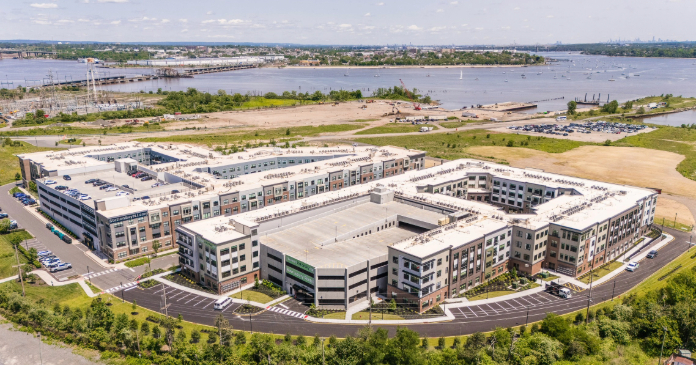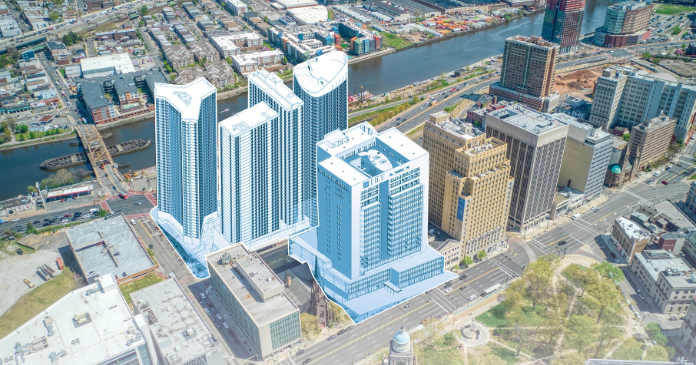
But inside Brooklyn’s 461 Dean—the world’s tallest modular building—half of the 363 rental apartments fall well below market rate. One-bedrooms, which range from 578- to 735-sq.-ft., start at $600 a month.
Developed by N.Y.-based Forest City Ratner Companies, the 32-story tower aims to explore modular design’s potential as an affordable solution to urban housing shortages. Before it opened, 84,000 prospective residents applied for its 181 affordable units, which are now available for lease.
The building, which opened in December 2016, is part of the 22-acre Pacific Park Brooklyn complex, located next to the Barclay’s Center sports arena. The non-modular apartments are a mix of studios, one- and two-bedrooms that range from $2,450- $4,750.
Modular construction—which includes parts that are assembled offsite and then moved into place, like an assembly line—is considered a more efficient, eco-friendly and less disruptive than conventional construction. The concept of building standardized units for assembly is borrowed from the systematic manufacturing industry.
“It’s something we’re going to be seeing more and more because it can answer one of the critical architectural questions we face today,” Christopher Sharples, founding principal at SHoP architecture firm in New York City.
“How do we efficiently and effectively add residential capacity to our growing cities in a way that reduces as much impact as possible on the environment?”
Moving toward modular
By 2050, the United Nations predicts 66 percent of the world’s population will live in cities—a move that will put pressure on urban housing.
As cities all over the world adapt to urbanization, modular construction has the potential to provide a solution for more affordable rents and faster construction. In fact, modular buildings have potential to reduce construction timelines by 30 percent to 50 percent.
“The success of completing 461 Dean in one of the densest urban environments in the U.S. reaffirms that this technology can be replicated virtually anywhere,” said Adam Greene, vice president of residential development at Forest City Ratner.
Modular construction is particularly effective in dense urban areas, where there’s little room for giant cranes, trucks and materials on site.
“New York is ripe for this. You think about urban environments and the first thing you think about is congestion,” said Stacy Scopano, a senior strategist at Autodesk architectural software firm and a member of the National Institute of Building Sciences off-site construction council.
“You don’t have a wide open meadow to lay down a batch delivery of hundreds of columns to install 10 this week and 10 the next.”
One block at a time
At first glance, the tower looks like any other shiny new apartment complex. But upon closer inspection, Tetris-like pods reveal a complex modular construction method. There are a total of 930 modules, which all fit together like a puzzle.
“This isn’t a pile of little boxes,” said Sharples. “We have units composed of two or even three modules combined, to create living spaces with lots of elbow room.”
Roughly 80 percent of the building was prepared offsite in a factory in the Brooklyn Navy Yard. Each pod was completely finished before assembly, down to the bathroom fixtures and appliances, plumbing, drywall, insulation, finishes, countertops and doorknobs. The only thing left to install was the wooden floors.
“You can’t think like a builder and make modular work,” said Sharples. “You need to think like a manufacturer and really reconceive how the different trades will work together in the new environment of the factory floor.”
Overnight, the team moved the finished modules to the construction site, lifted them into place and linked them together. The offsite method, Sharples said, decreases noise, pollution and congestion around the area. And since modular buildings have to be meticulously planned out, the method can dramatically reduce material waste.
“In most traditional projects, you assume 15 percent material waste, but you can get that down to single digits when homes are prefabricated,” said Scopano.
Ultimately, the method saved Forest City Ratner Companies about 20 percent on construction costs and reduced materials by 25 percent.
While the advantages of modular building are clear, 461 Dean still faced challenges. The construction, which started in early 2013, was originally scheduled to finish at the end of 2014 but the project was delayed two years due to a partnership disagreement.
“Like any new technology, modular construction will continue to evolve and become more efficient in the coming years,” said Greene.
Laying the ground work
The trend is not only growing in New York City but worldwide. For example, Austin-based startup Kasita has designed micro-homes that horizontally slide into a building’s steel framework. In addition, Chinese firm Broad Sustainable Building erected a 57-story modular construction building called Mini Sky City in just 19 days in 2015.
Although the building used some modular methods, it is considered the largest prefabricated tower in the world. This means it encompasses several different types of building methods. Almost all other modular projects to date have been less than 10 stories high.
Meanwhile, initiatives like Better Shelter, in partnership with UNHCR and IKEA Foundation, have used basic modular techniques to build refugee cabins for those displaced by conflict.
Scopano believes modularization will appeal to more people in the years ahead as the concept becomes more sophisticated.
“We’re seeing modular building taught in universities,” said Scopano. “The future of construction will be modular, more like what you would see in the automobile and manufacturing industries.”
Source: CNN Wire












